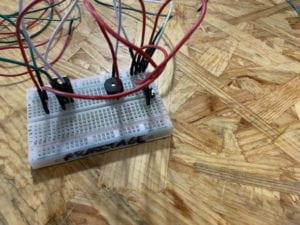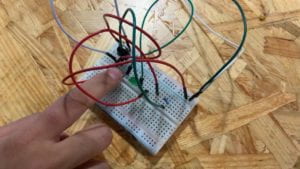Well, compared with most students, I think my process of accomplishing the recitation one may be more interactive since I lost all of my documentation and did it twice. However, the second time building circuit also helped me learn more about the application and useful connection tips on the bread broad. Frankly speaking, I didn’t even know that each lane inside the breadboard was connected and did a lot of inconvenient work. Moreover, maybe the most important thing this experience has taught me is that—-Always Keep The Documentation!!!
Record of building the circuit:

First material on the breadboard!

Building circuit 1
Circuit one is nearly here!
While at this time, accidents happened. When I pressed down the switch, the buzzer didn’t give out a sound. Instead, SMOKE went out. I quickly turned off the switch and checked if there were anything wrong. It seemed that the voltage regulator was misconnected and the electricity inside the circuit was reversed, BUT, as Professor Rudi said, you will never learn to make things until you break them 😜.

After rebuilding the circuit, I changed several voltage regulators and hardly found one working correctly.🙈

CIRCUIT ONE COMPLETED!!! IT’S NICE TO HEAR “BEEP” AFTER PRESSING THE BUTTON
.
The process of building the circuit two went down smoothly without any accidents. Probably it’s because I became more experienced after building the first circuit and the structure of circuit two was really simple.

Then came the circuit three. I think this was really strange because this was the only circuit that I wasn’t able to accomplish. Actually, I don’t think there was anything wrong with my wiring since other IMA students also came and helped me check the circuit. My conclusion is that the variable resistor may be broken, but anyway, I succeeded in building the fading circuit in the recitation two, which was also a way to make the LED dimmable.
Reflections and answers to the questions:
The first recitation has been greatly helpful to me since this was the first time I had been building something on a breadboard. I got to know the basic knowledge of using the breadboard, but I think the most important lesson I learned is something excluding the project—-always asking for help when you are not able to proceed on your own. This shouldn’t shame you, and it’s no use pretending to be knowledgeable. Moreover, I had a clearer picture of the interaction lab. It’s completely different from what I originally thought, (My initial picture of the interaction lab was more likely to be the things taught in the communication lab) but this doesn’t matter, and I like it. After all, students here at the interaction lab are expected to build something interactive, and novel. We should embrace the uncertainty and the future.
For question one, I think the circuits I build today include interactivity in the way they respond. For example, the author described in his text that interactivity is a cyclic process in which two actors alternately listen, think, and speak. In this case, the two actors are the circuit and I. After I acted, the circuit would respond or react to me in the way of beeping or lighting. It doesn’t matter whether this behavior was intentional or intellectual.
About the question two, I think the question is obvious. AI is an actual product of physical computing, yet we have seen a number of AI programs being able to create art pieces. I remember one of the paintings created by AI was even sold at a high price. Looking at the essence of circuits or programs, I think they do belong to a certain form of art. I believe this is also a reason why the interaction lab is a part of IMA.

Leave a Reply